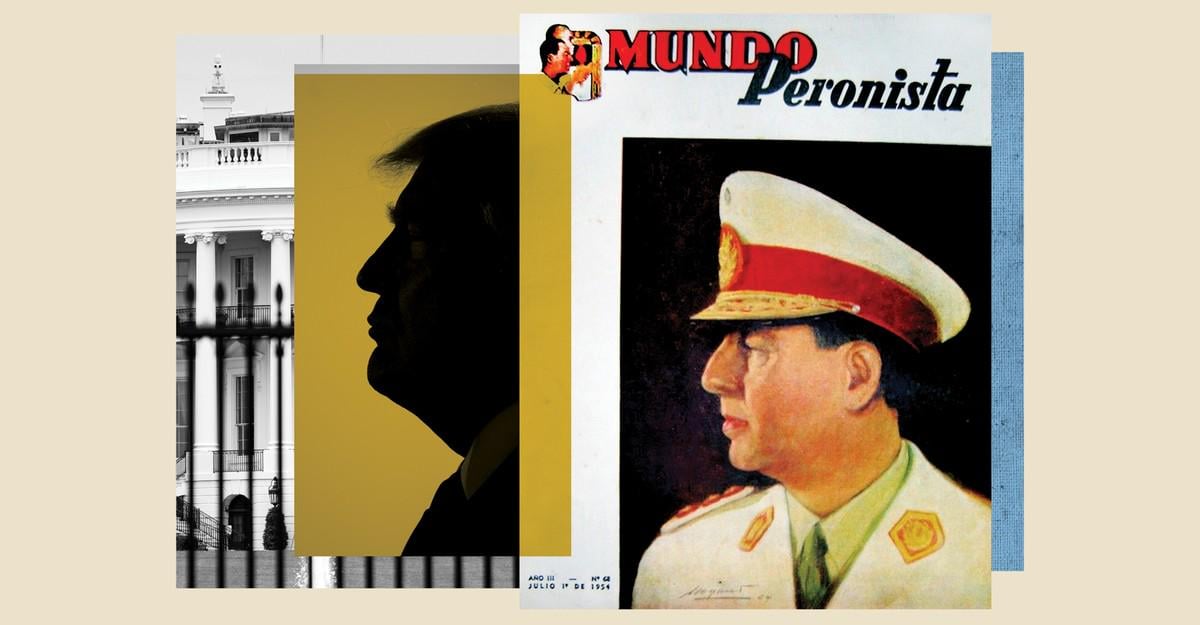
America’s Perón
https://www.theatlantic.com/economy/archive/2025/09/trump-peron-argentina-economy/684117/?utm_source=reddit&utm_campaign=the-atlantic&utm_medium=social&utm_content=edit-promo
Posted by theatlantic


America’s Perón
https://www.theatlantic.com/economy/archive/2025/09/trump-peron-argentina-economy/684117/?utm_source=reddit&utm_campaign=the-atlantic&utm_medium=social&utm_content=edit-promo
Posted by theatlantic
2 comments
Scott Lincicome: “When the populist strongman Juan Perón ran Argentina’s economy from his presidential palace in the mid-20th century—personally deciding which companies received favors, which industries got nationalized or protected, and which businessmen profited from state largesse—economists warned that the experiment would end badly. They were right. Over decades of rule by Perón and his successors, a country that had once been among the world’s wealthiest nations devolved into a global laughingstock, with uncontrollable inflation, routine fiscal crises, rampant corruption, and crippling poverty. Peronism became a cautionary tale of how *not* to manage an economy.
“President Donald Trump seems to have misunderstood the lesson. His second term has begun to follow the Peronist playbook of import substitution, emergency declarations, personal dealmaking, fiscal and monetary recklessness, and unprecedented government control over private enterprise. And, as with Argentina’s Peronism, much of U.S. economic policy making runs directly through the president himself.
“…Perón, for example, nationalized entire industries—railways, airlines, telecommunications, utilities—creating chronically loss-making state enterprises that endured for decades. Trump hasn’t gone nearly that far, but is exerting an astonishing degree of government control over private companies’ commercial operations. The Trump administration forced Japan’s Nippon Steel to give the U.S. president a “golden share” in U.S. Steel in order to acquire it, and required the U.S. semiconductor firms AMD and Nvidia to give the government a 15 percent cut of their China sales in exchange for export approvals. The administration also took a 15 percent stake in the rare-earth miner MP Materials and a 10 percent stake in Intel, in each case making Uncle Sam the company’s largest shareholder.
“…Trump has also flirted with Peronism in fiscal and monetary policy. Perón took control of Argentina’s central bank and used expansionary monetary policy to finance massive government spending and deficits, which led to chronic inflation. Trump, for his part, has already added trillions of dollars in new U.S. debt via the One Big Beautiful Bill Act, while also seeking to smash the independence of the Federal Reserve in order to adopt expansionary U.S. monetary policy in the face of still-warm inflation.
“…Trumpism isn’t full-blown Peronism yet. Large parts of the U.S. economy fortunately remain outside the president’s crosshairs and grasp. But each emergency declaration, Oval Office favor, and presidential intervention into private enterprise moves us closer to the Argentine model, and will make reversing course more difficult.”
Read more: [https://theatln.tc/05ufH6WS](https://theatln.tc/05ufH6WS)
They should have made their research. Peron ruled from 1946-1955 and then from 1973-1974. Inflation in the later half of the 1940s had far more to do with the usually forgotten aid Argentina gave to the UK during WW2, agreeing to sell food to the UK in exchanges for IOUs, and paying local farmers with monetary emission. The inflation from that emission was held back by the trade disruption caused by WW2 and ended up hitting in the postwar, combined with the bankrupt UK stating their IOUs (in pound sterling) couldn’t be converted to other currencies.
Now, if the writer would have bothered to do his research, he would have figured out that, indeed, gdp per capita barely grew during Peron’s first two terms, although the living standards and work conditions of the working class improved significantly. From 1955 to 1973 peronism was proscribed in Argentina – one would hardly call those proscribing peronism as “peronists”. The author should know that before writing, but apparently that’s demanding too much. But, in any case, if you check gdp per capita since 1955 (actually, since Peron’s fiscal adjustment by 1952) up to 1973, it grew a lot – quite the opposite of what the article suggests.
And if you continue to monitor gpd per capita after Peron’s death, you’ll find out Argentina only had periods of gdp growth under peronist administrations: Menem and the Kirchners. All non peronist governments after the 1973 oil crisis have consistently failed to deliver economic growth.
As for fiscal policy, Peron did an austerity plan in the early 1950s, the Menem administration mostly run primary surpluses through the 1990s and the early period of the Kirchner administration, up until the subprime crisis hit, had fiscal surpluses. I’m not sure if the author wants the USA to run fiscal and possibly trade surpluses, or if he thinks both things are a good idea for the USA.
But hey, we can’t let reality stand in the way of prejudices and call that journalism, right?
Comments are closed.